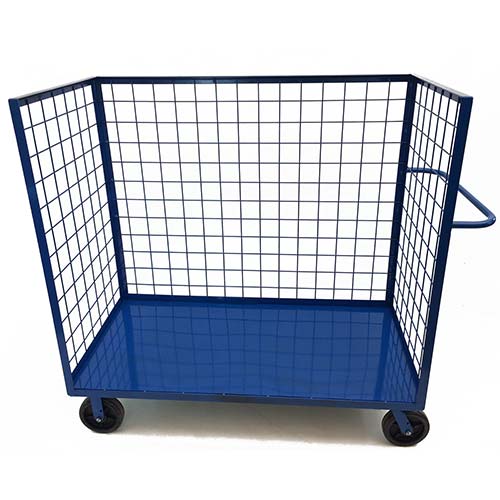In today’s fast-paced distribution and fulfillment environments, speed, accuracy, and efficiency are essential to meet growing customer expectations. One of the most important tools in this process is the logistics cart—a versatile material handling solution that plays a critical role in order picking, packing, and internal transport.
As warehouses strive to improve throughput and reduce labor costs, investing in well-designed logistics carts can lead to substantial performance gains. In this article, we’ll explore how logistics carts contribute to streamlined picking and packing workflows, what features to consider, and why custom carts often deliver the best results.
What Are Logistics Carts?
Logistics carts are mobile platforms designed for transporting goods, tools, and packaging materials within distribution centers, warehouses, or fulfillment operations. These carts are used across various stages of the order fulfillment process, including:
- Order picking from shelves or flow racks
- Batch picking multiple orders simultaneously
- Consolidating items at packing stations
- Replenishing packing supplies and shipping materials
- Transporting outbound cartons to shipping docks
Unlike standard warehouse carts, logistics carts are purpose-built for high-volume movement, ergonomic use, and efficient loading and unloading. They help reduce the number of steps in the picking process and support lean operations by minimizing wasted motion and travel time.
The Role of Logistics Carts in Order Picking
Order picking is one of the most labor-intensive and time-sensitive tasks in warehouse operations. Whether your facility uses zone picking, wave picking, or batch picking strategies, the layout and functionality of your logistics carts directly impact performance.
Here’s how logistics carts improve order picking:
1. Multi-Level Shelving
Logistics carts often include multiple shelf tiers, allowing workers to pick multiple SKUs simultaneously without needing to return to a central location. Shelves can be spaced to fit standard totes or shipping cartons, helping maintain order accuracy and ease of transport.
2. Ergonomic Design
Features like adjustable shelf heights, ergonomic push handles, and swivel casters reduce strain and fatigue for warehouse workers. This improves pick rates while lowering the risk of injury.
3. Batch Order Efficiency
By allowing pickers to gather items for multiple orders in one pass, logistics carts reduce travel time and increase throughput. Custom designs can include color-coded bins, vertical dividers, or digital pick-to-light integrations to help staff stay organized.
4. Compatibility with Warehouse Management Systems (WMS)
Modern carts can be equipped with scanner mounts, label printers, or device holders to keep warehouse staff connected to WMS platforms throughout the picking process.
How Logistics Carts Support Packing and Shipping
Packing operations rely on speed and consistency to keep pace with order flow. Logistics carts help streamline packing in several key ways:
- Transporting picked items directly to designated packing stations
- Holding pre-packed boxes ready for final inspection and labeling
- Delivering supplies such as tape, dunnage, and boxes where needed
- Supporting mobile packing in pop-up fulfillment environments
Some carts even include integrated work surfaces or removable bins to create mobile packing stations that can move with demand across the facility.
Custom vs. Off-the-Shelf Logistics Carts
While generic warehouse carts may serve basic needs, custom-designed logistics carts offer greater value for high-volume operations. Custom carts can be engineered to:
- Match the dimensions of your aisles, racks, or conveyor systems
- Accommodate specific bin or carton sizes
- Include part protection features for fragile items
- Support vertical storage to maximize space
- Integrate with automated systems or tugger trains
Custom carts are especially beneficial in e-commerce fulfillment, where SKU variety and order profiles frequently change. A tailored cart system reduces handling time, increases order accuracy, and helps scale operations as order volume grows.
Key Features to Look for in a Logistics Cart
If you’re considering investing in carts, here are some features that can maximize performance and ROI:
- Lightweight but durable steel or aluminum construction
- Heavy-duty, non-marking casters for smooth movement
- Adjustable or removable shelving
- Label holders or bin identification systems
- Foldable or nestable designs for compact storage
- Modular accessories like tool trays or scanner mounts
- Safety features like brakes or anti-tip designs
At Salco Engineering, we work closely with clients to design logistics carts that meet all of these needs while aligning with their specific workflows.
Industries That Benefit from Logistics Carts
Logistics carts are essential across many industries where high-volume material movement is required, including:
- E-commerce and retail fulfillment
- Third-party logistics (3PL)
- Automotive distribution
- Healthcare supply chain operations
- Manufacturing kitting and parts picking
- Grocery and foodservice warehousing
No matter the application, the goal is the same—move materials faster, safer, and with less labor.
Optimize Your Warehouse with Custom Logistics Carts
Whether you’re running a national fulfillment center or a regional distribution hub, the right carts can make a significant difference in operational efficiency. From boosting pick rates to improving employee ergonomics, these carts play a central role in achieving lean, responsive, and scalable warehouse operations.
At Salco Engineering & Manufacturing, we specialize in designing custom carts tailored to your environment, order flow, and equipment. Our carts are engineered for durability, ergonomics, and efficiency—and built to perform in demanding warehouse settings.
To learn more about how logistics carts can improve your picking and packing processes, or to request a quote for a custom design, visit our carts and trolleys page or contact us directly. We’re ready to help you move smarter.



